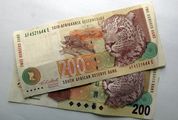Art exhibition sheds light on an eccentric snake man
by Chad Rossouw,
2015-11-23 21:16:03.0
DAVID Brits’s grandfather, John Wood, was a snake man — meaning he was a snake collector, antivenom medical researcher and show man, who had a travelling reptile exhibition in the ’70s. He was also a poet, a film-maker and a photographer. He is the kind of man whose story is begging to be told, which is what Brits attempts in his exhibition at Smith Studio gallery, Cape Town.
Brits has taken the large archive of newspaper cuttings and photographs that feature his grandfather as a starting point for his exhibition, titled Snakeman, which includes ink drawings and linocuts. "For many years I have been writing down and recording his stories, ordering out his photographs and letters for this purpose — archiving his life, so-to-speak."
The death of his grandfather, a larger-than-life persona, inspired Brits to work with this material. They were close. "He was one of my greatest teachers, and he shared his enthusiasm for nature and life with me in a very profound way. He taught me how to write poetry, about history, how to catch a snake, the names of spiders and scorpions, how to be a gentlemen, the best way to cut down a tree and how to shoot a gun."
While the show’s subtitle is "A Memorial Exhibition," the irony is Brits doesn’t so much tell the story of John Wood as think about the vagaries of memory and the tensions between the man remembered and the one depicted in newspapers.
Newspapers can’t print tone, the tone we see is an illusion created by fine dots called a half-tone pattern. Brits has taken specific crops of newspaper photographs, mostly of Wood’s hands holding snakes, and enlarged them to a massive scale.
He has then redrawn them in India ink. Up close one can only see the abstraction of the dots; the complete image can’t be detected. As one steps further away, the picture hidden in the medium emerges.
The American pop artist Roy Lichtenstein is famous for using a similar technique in his paintings from the ’60s. Lichtenstein took sections of pulp comics and blew them up, hand painting the printed dots. Lichtenstein wanted to see what would happen when a "cheap" media was elevated to high art. He was curious as to how the artist’s hand, the myth of the artist’s genius manifesting through gesture, had value. These ideas are embedded in Brits work.
Yet technology has shifted. Printing has become refined, and half-tones, even in newspapers, have become almost invisible to the naked eye. The messy, ungainly dots Brits depicts are distinctively set in the past. Enlarging them, glorifying them evinces a nostalgia. Brits isn’t only memorialising his grandfather, but also a time past.
Philosopher Walter Benjamin in his essay, The work of art in the age of mechanical reproduction, says that when technologies developed so that people were able to photograph and mass print art works, the benefits of mass distribution were offset by the loss of the specificity of the original. Benjamin called this the artwork’s "aura", a combination of its uniqueness, its materiality and its place in history. Benjamin suggests that this loss presented a radical break in how we understand and relate to images. Brits seems to be trying to reverse this process, taking mechanically reproduced images and reinstating their aura.
Creating an aura around the past in South Africa is a difficult undertaking. One has to pit personal memory against apartheid history, and one’s identity as a white person against the violence of whiteness. Brits’s previous work has treaded this line, looking at conscription and the border war, the grey areas where white masculinity came up against and in opposition to apartheid politics. In "Snake Man" his approach to this subject is softer and less ambivalent. "An acceptance of who one’s ancestors are," says Brits, "is in a way also the acceptance of oneself."
In addition to depictions of John Wood, Brits’s show reveals the hypnotic power of the snake, deeply imprinted into our psyches. Rendered in the same half-tone ink drawings are depictions of patches of snake skin. They verge even further into the abstract, into pure patterning. Yet our deep hidden monkey brain recognises the arrangement of dots as a snake, as a signifier of danger. Unlike the portraits of Wood, here the emphasis seems to be on pattern recognition, the evolutionary throwback for parsing danger (is that series of spots dappled shadow or a leopard?) that has led humans into being excellent interpreters of images.
In attempting to tell John Wood’s story this show is singularly unsuccessful. But in terms of thinking about memory versus representations in the media, the show has an undeniable force. Even more, seeing images appearing out of seemingly random dots is a joyful aesthetic experience.
* Independently produced Incorrigible Corrigall text subsidised by the gallery
• Snakeman will show at Smith Studio Gallery, 56 Church Street, Cape Town until January 9
-
Snake, 2015 (detail) linocut on Zerkall Litho Paper 110 x 76cm. Picture: SUPPLIED
-
The Handler, 2015 (detail) Indian ink on Fabriano Rosaspina, 70 x 100cm. Picture: SUPPLIED
-
The Proprietor, 2015 (detail) Indian Ink on Fabriano Rosaspina. 70 x 100cm. Picture: SUPPLIED
DAVID Brits’s grandfather, John Wood, was a snake man — meaning he was a snake collector, antivenom medical researcher and show man, who had a travelling reptile exhibition in the ’70s. He was also a poet, a film-maker and a photographer. He is the kind of man whose story is begging to be told, which is what Brits attempts in his exhibition at Smith Studio gallery, Cape Town.
Brits has taken the large archive of newspaper cuttings and photographs that feature his grandfather as a starting point for his exhibition, titled Snakeman, which includes ink drawings and linocuts. "For many years I have been writing down and recording his stories, ordering out his photographs and letters for this purpose — archiving his life, so-to-speak."
The death of his grandfather, a larger-than-life persona, inspired Brits to work with this material. They were close. "He was one of my greatest teachers, and he shared his enthusiasm for nature and life with me in a very profound way. He taught me how to write poetry, about history, how to catch a snake, the names of spiders and scorpions, how to be a gentlemen, the best way to cut down a tree and how to shoot a gun."
While the show’s subtitle is "A Memorial Exhibition," the irony is Brits doesn’t so much tell the story of John Wood as think about the vagaries of memory and the tensions between the man remembered and the one depicted in newspapers.
Newspapers can’t print tone, the tone we see is an illusion created by fine dots called a half-tone pattern. Brits has taken specific crops of newspaper photographs, mostly of Wood’s hands holding snakes, and enlarged them to a massive scale.
He has then redrawn them in India ink. Up close one can only see the abstraction of the dots; the complete image can’t be detected. As one steps further away, the picture hidden in the medium emerges.
The American pop artist Roy Lichtenstein is famous for using a similar technique in his paintings from the ’60s. Lichtenstein took sections of pulp comics and blew them up, hand painting the printed dots. Lichtenstein wanted to see what would happen when a "cheap" media was elevated to high art. He was curious as to how the artist’s hand, the myth of the artist’s genius manifesting through gesture, had value. These ideas are embedded in Brits work.
Yet technology has shifted. Printing has become refined, and half-tones, even in newspapers, have become almost invisible to the naked eye. The messy, ungainly dots Brits depicts are distinctively set in the past. Enlarging them, glorifying them evinces a nostalgia. Brits isn’t only memorialising his grandfather, but also a time past.
Philosopher Walter Benjamin in his essay, The work of art in the age of mechanical reproduction, says that when technologies developed so that people were able to photograph and mass print art works, the benefits of mass distribution were offset by the loss of the specificity of the original. Benjamin called this the artwork’s "aura", a combination of its uniqueness, its materiality and its place in history. Benjamin suggests that this loss presented a radical break in how we understand and relate to images. Brits seems to be trying to reverse this process, taking mechanically reproduced images and reinstating their aura.
Creating an aura around the past in South Africa is a difficult undertaking. One has to pit personal memory against apartheid history, and one’s identity as a white person against the violence of whiteness. Brits’s previous work has treaded this line, looking at conscription and the border war, the grey areas where white masculinity came up against and in opposition to apartheid politics. In "Snake Man" his approach to this subject is softer and less ambivalent. "An acceptance of who one’s ancestors are," says Brits, "is in a way also the acceptance of oneself."
In addition to depictions of John Wood, Brits’s show reveals the hypnotic power of the snake, deeply imprinted into our psyches. Rendered in the same half-tone ink drawings are depictions of patches of snake skin. They verge even further into the abstract, into pure patterning. Yet our deep hidden monkey brain recognises the arrangement of dots as a snake, as a signifier of danger. Unlike the portraits of Wood, here the emphasis seems to be on pattern recognition, the evolutionary throwback for parsing danger (is that series of spots dappled shadow or a leopard?) that has led humans into being excellent interpreters of images.
In attempting to tell John Wood’s story this show is singularly unsuccessful. But in terms of thinking about memory versus representations in the media, the show has an undeniable force. Even more, seeing images appearing out of seemingly random dots is a joyful aesthetic experience.
* Independently produced Incorrigible Corrigall text subsidised by the gallery
• Snakeman will show at Smith Studio Gallery, 56 Church Street, Cape Town until January 9


















Change: 1.37%
Change: 1.32%
Change: 2.91%
Change: 0.45%
Change: 3.09%
Data supplied by Profile Data
Change: 1.63%
Change: 0.83%
Change: 1.37%
Change: 0.00%
Change: 0.69%
Data supplied by Profile Data
Change: -2.04%
Change: -1.81%
Change: -1.61%
Change: -1.86%
Change: -1.48%
Data supplied by Profile Data
Change: -1.21%
Change: 0.31%
Change: -0.72%
Change: -1.39%
Change: 2.92%
Data supplied by Profile Data